3.4.1 Severe vs. Non-Severe Squall Lines: Shear
and CAPE

Research characterizing the environments of severe versus non-severe squall
lines observed in Oklahoma showed that the environments of both severe and
non-severe squall lines exhibit significant vertical wind shear, especially
at low levels. The magnitude of the shear on average is stronger for the
severe lines than for the non-severe lines. The average convective available
potential energy (CAPE) value for the severe lines (2260 J/kg in orange
shading, bottom) was significantly larger than for the non-severe lines
(1372 J/kg in orange shading, top). These results correspond to a more frequent
occurrence of supercells, bow echoes, and even severe pulsing ordinary storms
when the environmental buoyancy and/or shear are higher.
3.4.2 Review Question
What environmental conditions might lead you to anticipate the development
of a squall line composed of a significant number of supercells? Type your
answer then click Done.
Review Question Feedback
Given sufficient instability, if the hodograph shows strong and deep vertical
wind shear, you know that the environment is ripe for supercells. If, in
addition to this, you can identify a promising linear triggering mechanism,
you should anticipate the possibility of a line of supercells. Remember,
however, that cell interactions within the line may tend to reduce the possibility
of supercells at many locations, so you will need to look at the hodograph
and line orientation to anticipate storm and system motions as well.
3.4.3 Quantifying Low-Level Shear

MCSs occur over a wide range of instabilities and vertical wind shear profiles.
However, for any given CAPE, both the strength and longevity of the system
increase with increasing depth and strength of the vertical wind shear. In
general, weak low-level shear environments produce squall lines that spread
quickly upshear and weaken, while stronger low-level shear environments (right)
produce stronger, more long-lived lines composed of strong convective cells
and perhaps even bow echoes.
3.4.4 Which Shear Matters?

Please note that when estimating the ambient shear of a squall line environment, it is
the component of low-level shear perpendicular to the line orientation
that is most critical for controlling squall line structure and evolution.
For instance, in the graphic the three squall lines are evolving in environments
with identical shear profiles. Yet because of their orientations, they will
not likely evolve in the same way. The uppermost line, because the shear component
is entirely perpendicular to the line, will likely be a strong, long-lived
system. The bottom line, on the other hand, has no shear perpendicular to the
line, so it will, all things being equal, evolve as though in a no-shear environment
and be a weaker, shorter-lived system. The middle line is oriented between
the other two examples, and so should evolve to be a weak-to-moderate system
that lasts longer than the bottom line.
3.4.5 Review Question: Identify Key Differences Between
Squall Lines in Strong vs. Weak Shear Environments
What are the key structural and evolutionary differences possible in squall
lines growing in strongly sheared environments versus squall lines growing
in weak vertical wind shear environments?
Check All that apply, then click Done.
a) The system remains tilted downshear
longer.
b) The system may be longer lived.
c) The rear-inflow jet may be much stronger.
d) The stratiform precipitation area is less extensive during the mature stage.
e) Bowed segments are more likely
to form in the line.
d) The well-defined transition zone may be much broader
during the mature stage.
Review Question Feedback
You should have chosen all the options except d). Since the leading
line convection is more erect during the mature stage, there will be less
trailing stratiform precipitation, and either no transition zone or an ill-defined
one at best. Section 3.4 allows you to compare weakly and strongly sheared
squall line evolutions by viewing the conceptual models.
3.4.6 Review Question
Do squall lines require some minimum quantity of vertical wind shear in order
to be initiated?
Review Question Feedback
The answer is no. Squall lines do not require wind shear in order to be initiated,
as long as some linear forcing mechanism is present. However, increasing low-level
vertical wind shear increases the organization and longevity of squall lines,
so severe squall lines are usually associated with stronger low-level shear.
3.4.7 Shear and the Cold Pool
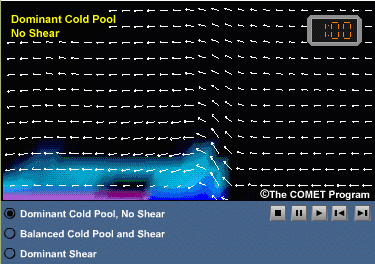
Click the image above to view animation.
Click the above image to view animation, or view still series below:



Actually, it is the ratio of the strength of the cold pool to the strength
of the shear that has the most control on the system strength and longevity.
If the cold pool is very strong (e.g., very cold), it takes more low-level
shear to produce deep lifting at the leading edge of the system than if the
cold pool is weak. Thus, this ratio affects the ability of the system to
continually trigger new cells. This animation shows model simulation vertical
cross sections depicting storm relative wind vectors and hypothetical cold
pools. As discussed in the “Shear and Convective Storms” module,
all things being the same, the optimal condition for the generation of new
boundary layer-based convective cells is when there is a balance between
the horizontal vorticity produced by the cold pool and the opposite horizontal
vorticity associated with the ambient low-level wind shear.
For more information on shear see the Mesoscale Meteorology module, Principles
of Convection III: Shear and Convective Storms.
3.4.8 Review Question: Cold Pool Strength
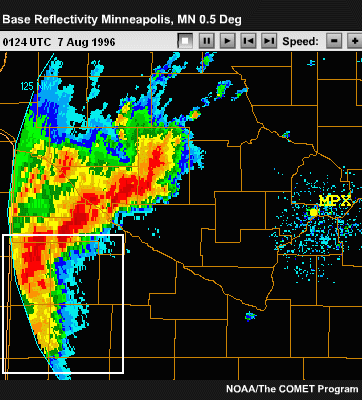
Click the image above to view animation.
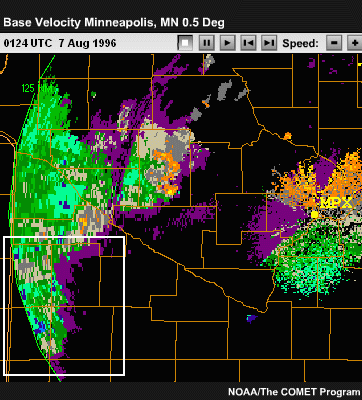
Click the image above to view animation.
Review these two radar loops focusing on the bowing segment in the box, then
answer the following question by choosing the most appropriate answer to fill
in the blank.
Based on the radar loops, I believe the cold pool circulation is ______________
the environmental shear in the boxed area.
a) stronger than
b) weaker than
c) equal to
Review Question Feedback
The weak reflectivities in the center of the bowing line segment with higher
reflectivities at the ends of the bow indicate that the cold pool is likely
stronger than the environmental shear in the center. We can infer this because
during the loop we observe reflectivity values in the center of the bow weaken
due to the advancing RIJ (see the velocity loop), and also because the strengthening
cold pool is causing the cells to tip further rearward and become weaker and
less erect than at the line ends. When this happens, radar reflectivity data
can be very misleading. The center of the bow looks like it is weakening while
damaging surface winds can be occurring at the surface.
3.4.9 Defining Shear Regimes
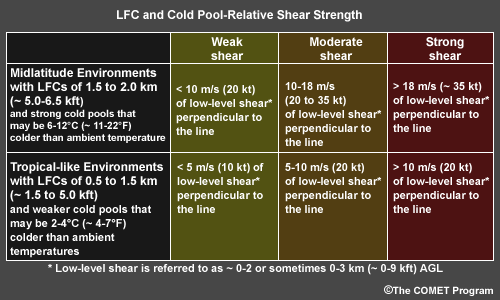
The height of the level of free convection (LFC) also has a significant effect
on system strength and longevity. Systems in high-LFC environments require
more lifting at the leading edge of the cold pool to continue initiating new
cells than do systems in environments with low LFCs. Thus, for a given shear
and cold pool strength, a system is more likely to be stronger and longer-lived
in a low-LFC environment than in a high-LFC environment. These tables provide
guidelines for quantifying shear strength relative to cold pool strength and
LFC height.
3.4.10 Reality vs. Conceptual Evolution
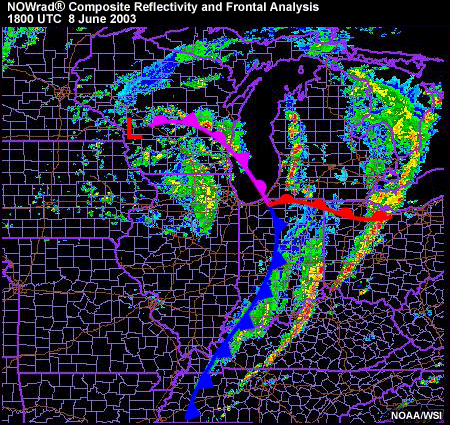
Of course it is important to recognize that squall lines do not develop
in isolation from all other mesoscale and synoptic-scale features that can
significantly impact their evolution. For instance, a cold front can continually
retrigger a squall line, even in the absence of significant low-level shear.
This process can greatly increase the squall line’s lifetime beyond
what would be expected based on simple cold pool/shear interactions alone.
Also, MCS-favorable shear and buoyancy conditions usually do not occur randomly,
but most often develop as a result of certain favored synoptic patterns.
These will be elaborated on later in the module.
As shown in this example, squall line evolution relative to a linear forcing
mechanism, such as a dryline or front, is quite complex. When first triggered,
the relationship tends to be the clearest with cells forming at or in advance
of the linear forcing feature. Cold fronts aloft often lead the surface
position of a front resulting in convection firing ahead of the surface front.
However, once the squall line creates its own system gust front, the subsequent
system evolution becomes more complicated. Depending on many factors including
the environmental wind shear and stability profiles, and the microphysics
of the squall line storms affecting the “coldness” of the cold
pool etc., the system gust front can stay with the line, or advance out well
ahead of the original line where it may or may not trigger new storms. Despite
these real world complications, there are some simple squall line motion
concepts that are worthy of discussion.
End of Section 3.4: Squall Lines - Shear and the Cold Pool










